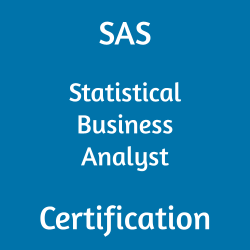A00-240 Dumps PDF, or sample questions & practice test combination; what should be your study material choice to become SAS Certified Statistical Business Analyst Using SAS 9 – Regression and Modeling?

If you are keen to pass the A00-240 exam on the first attempt, you should focus on making a study guide and follow it rigorously. When it comes to the study materials, practice tests have proved to be the more reliable source than dumps till date.
What Is the A00-240 Exam Structure?
The SAS Statistical Business Analyst exam is a multiple-choice exam, with 60 questions. You need to get a 68%% mark to pass the SAS Statistical Business Analyst exam. The SAS Certified Statistical Business Analyst Using SAS 9 – Regression and Modeling is suitable for candidates who are interested to learn more on the Advanced Analytics. The official price for the exam is $180 (USD).
What Should Be Your Study Method for the A00-240 Exam Preparation?
Once you are determined to take the A00-240 exam, you must get ready with a study guide that combines all your necessary actions during the preparation and materials in one place.
Work on the A00-240 Syllabus Topics:
The basic action of the A00-240 exam candidate should be going through the syllabus details and making out a chart to cover the syllabus topics on time. When it comes to covering the syllabus topics, books and online resources work best to ace the exam.
Success in the A00-240 exam is highly dependent on grasping the syllabus topics from the core. The more grasp you have, the more is the chance to succeed quickly. Do not hurry to learn the exam topics; learn one at a time.
Increase Your Productivity through Routine Making:
How to make your study schedule the most productive? If the aspirant follows a planned routine, he is going to experience a more productive preparation. If you want to enhance your productivity during the preparation, you must set aside your study hours. Focusing on daily study would help to learn the syllabus topics in a better manner.
Develop Writing Habit:
If you develop the habit of writing essential points during the study, you can revise quickly through these notes. Your study routine should be such that you can properly utilize the study resources. Therefore, follow some proven steps to pass the exam.
When Is the Right Time to Explore A00-240 Sample Questions & Mock Tests?
- The potential A00-240 certification candidates should not restrict themselves to learning the syllabus topics only. They can add more value to their preparation; if they explore different A00-240 sample questions through PDF format or regular format, their knowledge base could become stronger.
- The best time to explore sample questions is at the end of syllabus completion. Many valuable websites offer trusted and free sample questions for the A00-240 exam preparation.
- The preparation process is always better with these sample questions and practice test combinations. Many aspirants opt for the A00-240 dumps PDF materials and end up losing confidence in the exam hall during the actual exam preparation process.
- You can learn from the dumps materials, but working with A00-240 dumps PDF won’t help to assess your preparation level. Taking A00-240 mock exams would help the aspirant to get ready with the actual exam structure, and a candidate becomes an expert regarding time management through this process.
- Therefore, drop your focus from A00-240 exam related dumps PDF and get valuable insights through SAS Statistical Business Analyst practice tests.
- AnalyticsExam.com offers one of the most valuable practice tests for self assessment. The time-based practice tests help an aspirant to gain ideas on their time management level and answering capacity. The candidates may face difficulty during initial attempts, but through gradual practice their knowledge base, speed and marks improve.
Here Are Few A00-240 Sample Questions for Your Knowledge:
01. An analyst is screening for irrelevant variables by estimating strength of association between each input and the target variable. The analyst is using Spearman correlation and Hoeffding’s D statistics in the CORR procedure.
What would likely cause some inputs to have a large Hoeffding and a near zero Spearman statistic?
a) nonmonotonic association between the variables
b) linear association between the variables
c) monotonic association between the variables
d) no association between the variables
Answer: a
02. When selecting variables or effects using SELECTION=BACKWARD in the LOGISTIC procedure, the business analyst’s model selection terminated at Step 3.
What happened between Step 1 and Step 2?
a) DF increased.
b) AIC increased.
c) Pr > Chisq increased.
d) – 2 Log L increased.
Answer: d
03. Which statement is an assumption of logistic regression?
a) The sample size is greater than 100.
b) The logit is a linear function of the predictors.
c) The predictor variables are not correlated.
d) The errors are normally distributed.
Answer: b
04. An analyst builds a logistic regression model which is 75% accurate at predicting the event of interest on the training data set. The analyst presents this accuracy rate to upper management as a measure of model assessment.
What is the problem with presenting this measure of accuracy for model assessment?
a) This accuracy rate is redundant with the misclassification rate.
b) It is pessimistically biased since it is calculated from the data set used to train the model.
c) This accuracy rate is redundant with the average squared error.
d) It is optimistically biased since it is calculated from the data used to train the model.
Answer: d
05. An analyst has determined that there exists a significant effect due to region. The analyst needs to make pairwise comparisons of all eight regions and wants to control the experimentwise error rate.
Which GLM procedure statement would provide the correct output?
a) lsmeans Region / pdiff=all adjust=dunnett;
b) lsmeans Region / pdiff=all adjust=tukey;
c) lsmeans Region / pdiff=all adjust=lsd;
d) lsmeans Region / pdiff=all adjust=none;
Answer: b





